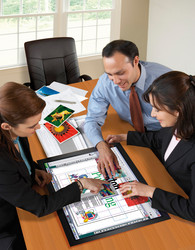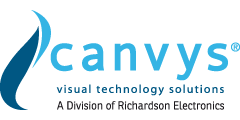Multi-Touch
What is Multi-Touch?
Despite increased consumer awareness of the "touch interface" courtesy of an expanding selection of touch-enabled consumer devices, the intricacies and varieties of touch technologies is a topic not fully understood by the gesture touch community. Courtesy of the product positioning of dozens of touch technology manufacturers, the filtering of bloggers and the responses posted by the larger touch community, mixed messages exist about how certain technologies work and what the true touch capabilities are for each technology.
To help create a basis for technology comparisons, below is a discussion of the various applicable touch input terms and the touch technologies that reliably recognize these input categories.

Image showing Multi-Touch Application
Single Touch
Single Touch occurs when a finger or stylus creates a touch event on the surface of a touch sensor or within a touch field so it is detected by the touch controller and the application can determine the X,Y coordinates of the touch event. These technologies have been integrated into millions of devices and typically do not have the ability to detect or resolve more than a single touch point at a time as part of their standard configuration.
Single Touch With Pen Input
Single Touch with Pen input functionality can range from a simple, inactive pointer or stylus to complex, active tethered pens. Inactive pens enable the same input characteristics as a finger, but with greater pointing accuracy, while sophisticated, active pens can provide more control and uses for the touch system with drawing and palm rejection capabilities, and mouse event capabilities.
Single Touch With Gesture
Enhancements to firmware, software and hardware by many single touch technologies have increased their touch functionality. Some touch technologies can use advanced processing capabilities to "detect" or recognize that a second touch event is occurring, which is called a “gesture event”. Since single touch systems can’t resolve the exact location of the second touch event they rely on algorithms to interpret or anticipate the intended gesture event input. Common industry terms for this functionality are two-finger gestures, dual touch, dual control, and gesture touch.
Two Touch
Two Touch refers to a touch system that can detect and resolve two discrete, simultaneous touch events. The best demonstration of Two Touch capability is to draw two parallel lines on the screen at the same time. Two Touch systems can also support gesturing.
Multi-Touch
Multi-Touch refers to a touch system’s ability to simultaneously detect and resolve a minimum of 3+ touch points. All 3 or more touches are detected and fully resolved resulting in a dramatically improved touch experience. Multi-Touch is considered by many to become a widely-used interface mainly because of the speed, efficiency and intuitiveness of the technology.
Touch Capabilities Comparison
| Touch Technology | Single Touch | Single Touch/Pen | Single Touch/Gesture | Two Touch | Multi-Touch |
| Bending Wave (DST) | yes | any stylus | Gesture-Upgrade | no | no |
| Infrared (IR) | yes | special stylus | Gesture-Upgrade | yes | yes |
| Optical | yes | special stylus | Gesture-Upgrade | yes | yes* |
| Projected Capacitive | yes | special stylus | Standard | yes | yes |
| Resistive | yes | any stylus | Gesture-Upgrade | no** | no |
| Surface Acoustic Wave (SAW) | yes | special stylus | Gesture-Upgrade | no | no |
| Surface Capacitive | yes | any stylus | Gesture-Upgrade | no | no |
* Optical technology with 2+ cameras may be capable of Two Touch and Multi-Touch with gesture upgrades.
** Matrix resistive technology may be capable of Two Touch and Multi-Touch, but they are not widely used.
Content and images of 3M were reproduced with permission © 3M 2010. All rights reserved.
